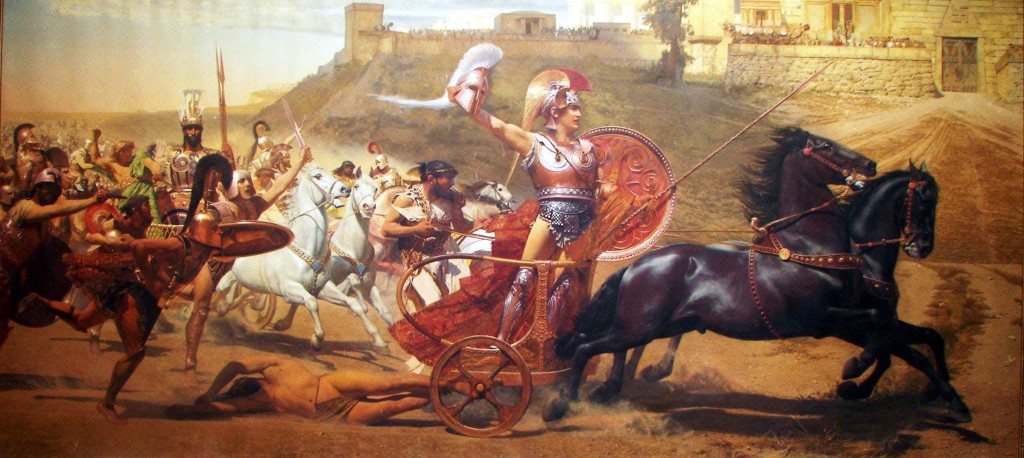Strategy from Achilles to the RAND Corporation

Lawrence Freedman, Strategy: A History (New York: Oxford University Press USA, 2013).
I had the opportunity last week to hear Sir Lawrence Freedman speak in about his new book, Strategy: A History, at the Woodrow Wilson International Center for Scholars. Since then I’ve been plowing my way through this “don’t drop it on your foot” opus. Freedman, of course, is famous for his book The Evolution of Nuclear Strategy, his official history of the Falklands War, and a long career filled with other important works. This is the kind of book that only someone with such a lengthy and intellectually fecund career could produce. Strategy: A History is easily the most ambitious book that I have read in many years. It bears comparison to Azar Gat’s A History of Military Thought from the Enlightenment to the Cold War, except that it starts earlier than Gat’s work. In fact, Freedman starts with chimpanzees and then moves smartly through the Bible, Homer, Thucydides, and Plato and onward. Freedman does not limit himself to military strategy. Rather he interprets strategy broadly, making major forays into business, nonviolent activism, political campaigning as well as the rhetoric and philosophy underpinning strategy.
Freedman sets up Achilles and Odysseus as two poles in one the book’s key themes. Achilles represents force and Odysseus represents guile. Thinkers such as Jomini, Clausewitz and Mahan enunciate strategic philosophies rooted in force. So, too, does God. There is a fascinating discussion of the “Ten Plagues as Strategic Coercion” that will resonate with anyone who has read Thomas Schelling or Herman Kahn. Guile, of course, is hallmark of strategists such as Sun Tzu, Machiavelli, Liddell Hart, and Satan. Yes, the title of Chapter 5 is “Satan’s Strategy.” It analyzes Satan as found in Milton’s Paradise Lost.
This theme carries all the way forward to recent debates, such as maneuver versus attrition. Ultimately, Freedman places more stock in force than in guile. If guile doesn’t work, there is no Plan B. What would David have done if the stone from his sling had missed or if Goliath’s helmet had just been slightly lower in front? Surprise would have been lost, Goliath would have divined David’s method, and the young Israelite would have been unable to defend himself against Goliath’s overwhelming force. Here, I think Freedman is on shaky ground. After all, in any given situation there is the possibility of the unexpected; it is simply a question of divining what that unexpected approach is. At a broader level, Freedman might have profitably included a discussion of covert action or what the Soviets called “active measures.” Surely these are examples of the use of guile. The KGB’s moniker of “The Sword and Shield of the Party” might have suggested that such operations had a place in this work.
Freedman places great stock in the formation of coalitions as a consistently reliable strategy. Indeed, this is one of the strategic hallmarks of chimpanzees. He notes that alpha male chimpanzees are seldom overthrown by bigger, badder males but rather by coalitions of weaker males. The ability to form coalitions is also one of the reasons that the emphasis placed by military strategists on the decisive battle which would be tantamount to political victory is problematic and has been, according to Freedman, since the Battle of Borodino in 1812. Defeated parties can regroup, often by finding allies. They can also engage in popular resistance.
Another important theme that weaves throughout the length of the book is the limits of strategy. Freedman cites Tolstoy who, in War and Peace, shows that events unfold as a result of the individual choices of innumerable lower level actors rather than because of Napoleon, who thinks he is in control. This argument appears early in the book but it sets up a discussion five hundred pages later of Mancur Olson and his work at the RAND Corporation on the “difficulties of large and dispersed group ever acting as a political force” due to the free rider problem. This, in turn, leads to a discussion of Robert Axelrod’s famous work on The Evolution of Cooperation which said, that cooperation can indeed come out of competitive systems.
Freedman also takes on the idea of a strictly rational, calculating strategist, highlighting the well-known limits of rational choice theory and, indeed, of conscious intellectual decision-making. After a brief discussion of dopamine neurons and the orbitofrontal cortex, Freedman has a fascinating discussion of what “System 1” thinking (rapid and intuitive) and “System 2” thinking (slow, conscious, and analytical) can each bring to the table. Strategy has typically been portrayed as a System 2 function but he says that “one way to think of [it] was as a System 2 process engaged in a tussle with System 1 thinking.”
Noting the power of stories to human beings—and their omnipresence in business school and business literature—Freedman endorses the idea of strategy as narrative. In a compelling turn of a phrase, he talks about “considering strategy as a story about power told in the future tense from the perspective of a leading character.” However, this story will not necessarily have a climax (or a decisive battle). Rather, it is more like a soap opera in which one storyline may come to an end but that only sets up another plot of confrontation.
It should be clear that Strategy: A History spins off interesting and startling diverse ideas every few pages. With a book of this scope anybody can find something to disagree with but nobody can come away from this book without feeling enriched and intellectually challenged. It will live on as a classic.
Mark Stout is a Senior Editor at War on the Rocks. He is the Director of the MA Program in Global Security Studies at Johns Hopkins University’s School of Arts and Sciences in Washington, DC.

